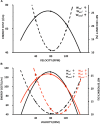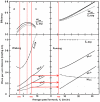Locomotion as a Powerful Model to Study Integrative Physiology: Efficiency, Economy, and Power Relationship
- PMID: 30618802
- PMCID: PMC6297284
- DOI: 10.3389/fphys.2018.01789
Locomotion as a Powerful Model to Study Integrative Physiology: Efficiency, Economy, and Power Relationship
Abstract
Locomotion is the most common form of movement in nature. Its study allows analysis of interactions between muscle functions (motor) and lever system arrangements (transmission), thereby facilitating performance analysis of various body organs and systems. Thus, it is a powerful model to study various aspects of integrative physiology. The results of this model can be applied in understanding body functions and design principles as performance outputs of interest for medical and biological sciences. The overall efficiency (effoverall ) during locomotion is an example of an integrative parameter, which results from the ratio between mechanical output and metabolic input. Although the concepts of cost (i.e., metabolic expenditure relative to distance) and power (i.e., metabolic expenditure relative to time) are included in its calculation, the effoverall establishes peculiar relations with these variables. For a better approach to these aspects, in this study, we presented the physical-mathematical formulation of efficiency, as well as its conceptual definitions and applications. Furthermore, the concepts of efficiency, cost, and power are discussed from the biological and medical perspectives. Terrestrial locomotion is a powerful model to study integrative physiology in humans, because by analyzing the mechanical and metabolic determinants, we may verify the efficiency and economy relationship through locomotion type, and its characteristics and restrictions. Thus, it is possible to elaborate further on various improved intervention strategies, such as physical training, competition strategies, and ergogenic supplementation.
Keywords: economy; efficiency; gait; mechanical work; metabolic cost; optimal walking speed; self-selected walking speed.
Figures








Similar articles
-
Power equations in endurance sports.J Biomech. 1990;23(9):865-81. doi: 10.1016/0021-9290(90)90352-4. J Biomech. 1990. PMID: 2211732
-
On the simple calculation of walking efficiency without kinematic information for its convenient use.J Physiol Anthropol. 2019 Dec 30;38(1):17. doi: 10.1186/s40101-019-0211-4. J Physiol Anthropol. 2019. PMID: 31888750 Free PMC article.
-
Mechanical efficiency and metabolic cost as measures of learning a novel gross motor task.J Mot Behav. 1987 Jun;19(2):240-64. doi: 10.1080/00222895.1987.10735410. J Mot Behav. 1987. PMID: 14988061
-
Mechanical and muscular factors affecting the efficiency of human movement.Med Sci Sports Exerc. 1985 Jun;17(3):326-31. Med Sci Sports Exerc. 1985. PMID: 3894869 Review.
-
The science of cycling: physiology and training - part 1.Sports Med. 2005;35(4):285-312. doi: 10.2165/00007256-200535040-00002. Sports Med. 2005. PMID: 15831059 Review.
Cited by
-
Mechanical energy on anaerobic capacity during a supramaximal treadmill running in men: Is there influence between runners and active individuals?Physiol Rep. 2023 Mar;11(5):e15564. doi: 10.14814/phy2.15564. Physiol Rep. 2023. PMID: 36898692 Free PMC article.
-
Determination of speed and assessment of conditioning in horses submitted to a lactate minimum test-alternative approaches.Front Physiol. 2024 Apr 25;15:1324038. doi: 10.3389/fphys.2024.1324038. eCollection 2024. Front Physiol. 2024. PMID: 38725567 Free PMC article.
-
Can walking capacity predict respiratory functions of people with Parkinson's disease?Front Neurol. 2025 Mar 26;16:1531571. doi: 10.3389/fneur.2025.1531571. eCollection 2025. Front Neurol. 2025. PMID: 40206294 Free PMC article.
-
Physiological Predictors of Maximal Incremental Running Performance.Front Physiol. 2020 Aug 5;11:979. doi: 10.3389/fphys.2020.00979. eCollection 2020. Front Physiol. 2020. PMID: 32848890 Free PMC article.
-
Nordic walking training in elderly, a randomized clinical trial. Part II: Biomechanical and metabolic adaptations.Sports Med Open. 2020 Jan 13;6(1):3. doi: 10.1186/s40798-019-0228-6. Sports Med Open. 2020. PMID: 31932999 Free PMC article.
References
LinkOut - more resources
Full Text Sources

